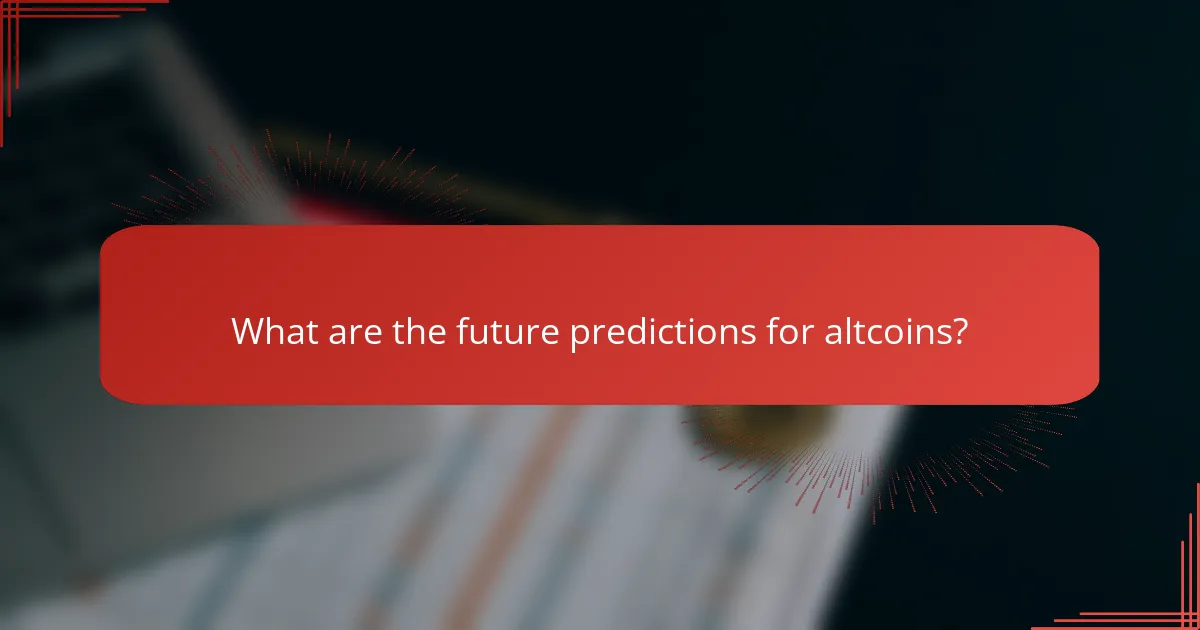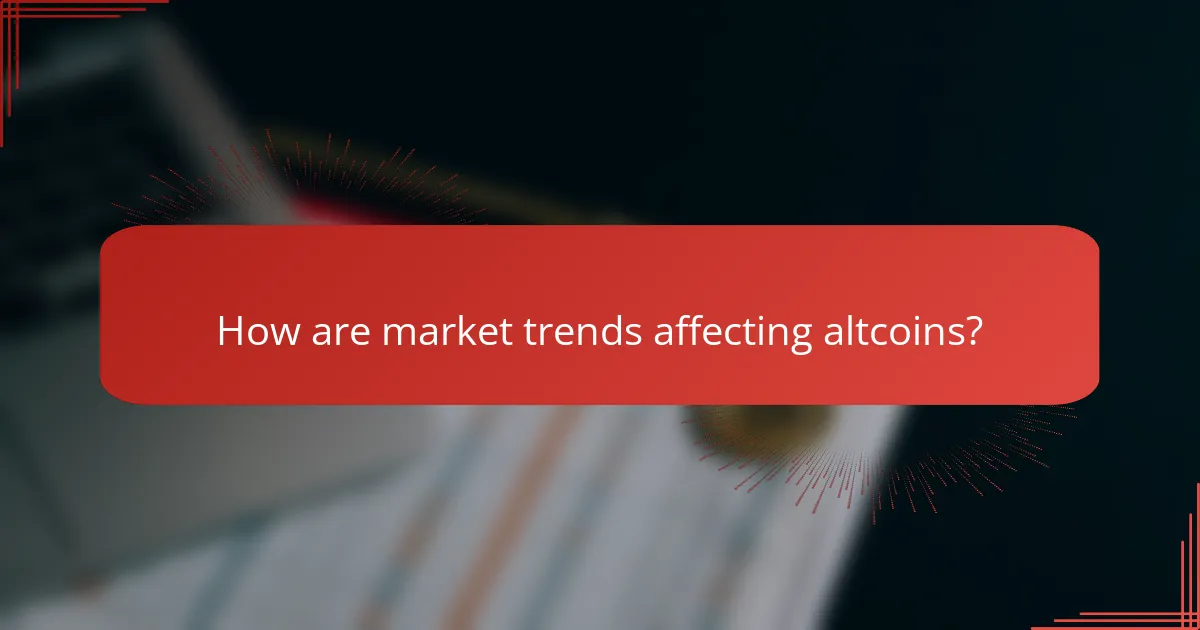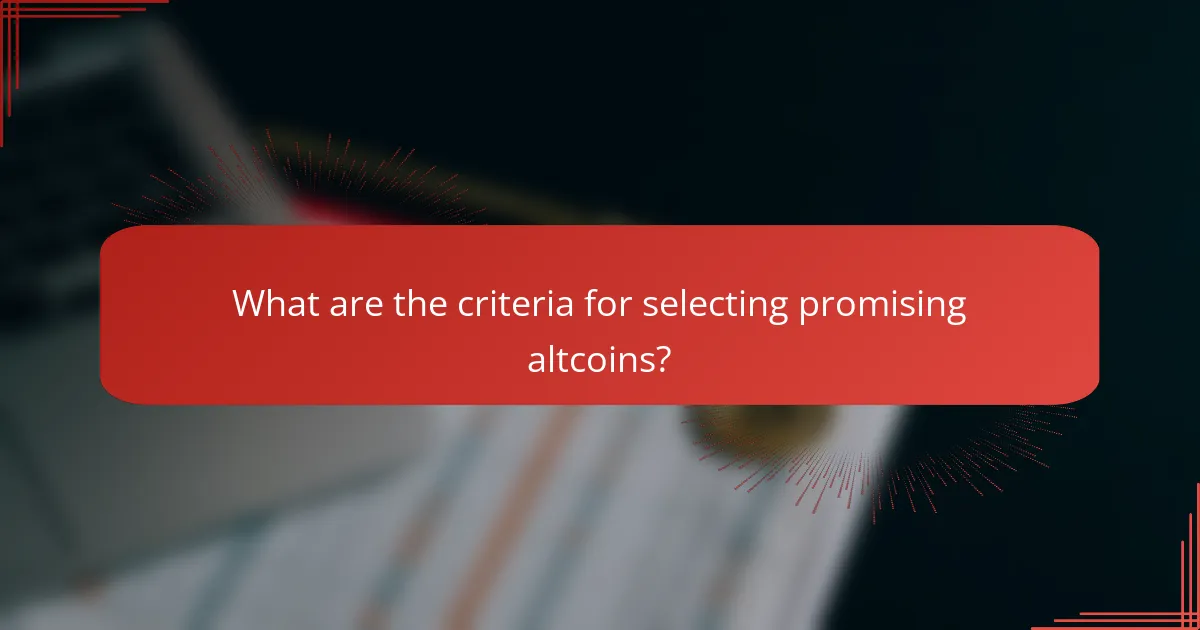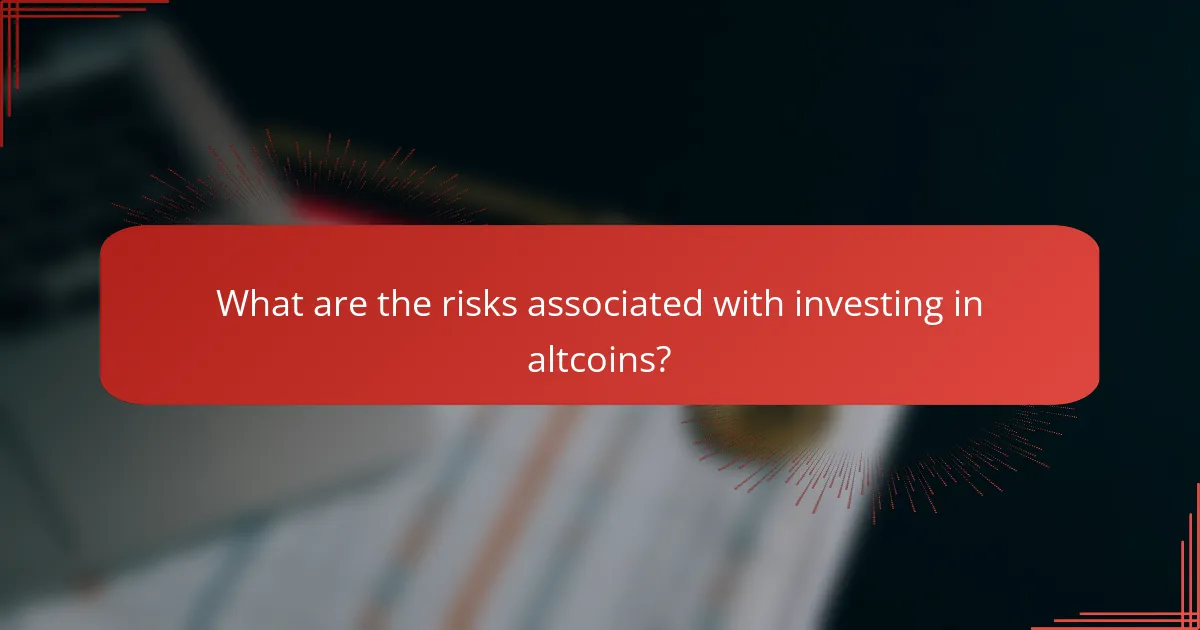The future of altcoins appears promising, with predictions indicating increased adoption and innovation driven by technological advancements and regulatory changes. Market trends play a crucial role in shaping altcoin prices and adoption, often reflecting broader investor sentiments. Additionally, the growing interest from institutional investors is expected to enhance market stability and credibility, further solidifying the position of altcoins in the cryptocurrency landscape.

What are the future predictions for altcoins?
Future predictions for altcoins suggest a growing role in the cryptocurrency market, driven by increased adoption, technological advancements, and evolving regulations. Analysts anticipate that altcoins will continue to diversify and innovate, appealing to both retail and institutional investors.
Increased adoption by retail investors
Retail investors are increasingly turning to altcoins as they seek alternatives to Bitcoin and Ethereum. This trend is fueled by the availability of user-friendly platforms and educational resources that make investing in altcoins more accessible. As more individuals invest, the demand for altcoins is expected to rise, potentially driving prices higher.
Investors should consider diversifying their portfolios with altcoins that show strong fundamentals and community support. However, they should also be cautious of market volatility and conduct thorough research before investing.
Emergence of new technologies
New technologies are continually emerging within the altcoin space, enhancing their functionality and appeal. Innovations such as decentralized finance (DeFi), non-fungible tokens (NFTs), and layer-2 scaling solutions are reshaping how altcoins operate and interact with users. These advancements can lead to increased utility and adoption among various sectors.
Investors should keep an eye on projects that leverage cutting-edge technology, as they may offer significant growth potential. However, it’s crucial to assess the viability and long-term sustainability of these technologies before committing funds.
Regulatory developments impacting market
Regulatory developments play a significant role in shaping the future of altcoins. Governments worldwide are increasingly focusing on creating frameworks to govern cryptocurrencies, which can impact market dynamics. Positive regulations may enhance investor confidence, while stringent rules could stifle innovation and growth.
Staying informed about regulatory changes in key markets, such as the United States and the European Union, is essential for altcoin investors. Understanding how these regulations affect specific altcoins can help in making informed investment decisions and mitigating risks.

How are market trends affecting altcoins?
Market trends significantly influence altcoins, often dictating their price movements and adoption rates. As investors shift their focus and strategies, altcoins can experience volatility based on broader market sentiments and emerging technologies.
Shift towards decentralized finance (DeFi)
The rise of decentralized finance (DeFi) has transformed the altcoin landscape, with many projects focusing on lending, borrowing, and trading without traditional intermediaries. This shift has led to increased demand for altcoins that facilitate DeFi applications, such as stablecoins and governance tokens.
Investors should consider the utility of altcoins within DeFi ecosystems, as those with strong use cases may see better performance. Additionally, monitoring regulatory developments in DeFi can help gauge potential risks and opportunities in this rapidly evolving sector.
Impact of Bitcoin’s performance on altcoins
Bitcoin often serves as a bellwether for the entire cryptocurrency market, including altcoins. When Bitcoin experiences significant price movements, altcoins typically follow suit, either amplifying gains or losses depending on market sentiment.
Traders should watch Bitcoin’s price trends closely, as a bullish Bitcoin market can lead to increased investment in altcoins, while bearish trends may prompt investors to retreat to more stable assets. Understanding the correlation between Bitcoin and altcoins can aid in making informed investment decisions.
Trends in NFT-related altcoins
The popularity of non-fungible tokens (NFTs) has spurred the development of altcoins specifically designed for NFT marketplaces and platforms. These altcoins often provide unique features such as lower transaction fees or enhanced security for digital assets.
Investors should evaluate the underlying technology and community support for NFT-related altcoins, as these factors can significantly impact their long-term viability. Keeping an eye on major NFT sales and partnerships can also provide insights into which altcoins may gain traction in the market.

What role does institutional investment play in altcoins?
Institutional investment significantly influences the altcoin market by providing liquidity, credibility, and stability. As large financial entities allocate funds to altcoins, they enhance market legitimacy and can drive price appreciation through increased demand.
Growing interest from hedge funds
Hedge funds are increasingly diversifying their portfolios by investing in altcoins, attracted by the potential for high returns. Many funds are allocating a small percentage of their assets, often in the range of 1-5%, to cryptocurrencies, including altcoins, to capitalize on market volatility.
This growing interest is reflected in the establishment of dedicated cryptocurrency funds and the hiring of experts in blockchain technology, signaling a long-term commitment to this asset class.
Investment strategies of major firms
Major firms typically adopt various strategies when investing in altcoins, including long-term holding, trading based on market trends, and participating in initial coin offerings (ICOs). Some firms focus on established altcoins with strong fundamentals, while others may invest in emerging projects with high growth potential.
Risk management is crucial; firms often use hedging techniques to mitigate potential losses in this volatile market. Diversification across multiple altcoins can also help spread risk and enhance returns.
Case studies of institutional purchases
Several high-profile institutional purchases have highlighted the growing acceptance of altcoins. For instance, a well-known hedge fund recently allocated a significant portion of its portfolio to Ethereum, citing its smart contract capabilities and robust developer community as key factors.
Another example includes a major investment firm that invested in a basket of altcoins, focusing on those with strong use cases in decentralized finance (DeFi). These case studies illustrate how institutions are not only investing but also shaping the future landscape of altcoins.

What are the criteria for selecting promising altcoins?
Selecting promising altcoins involves evaluating several key criteria that can indicate their potential for growth and stability. Investors should consider factors such as market capitalization, liquidity, technology, use cases, and the strength of the development team and community engagement.
Market capitalization and liquidity
Market capitalization refers to the total value of an altcoin, calculated by multiplying its current price by the total supply of coins. A higher market cap often indicates a more established coin, while liquidity reflects how easily an asset can be bought or sold without affecting its price. Look for altcoins with a market cap in the low millions to billions and sufficient trading volume to ensure you can enter and exit positions smoothly.
When assessing liquidity, consider the trading pairs available on major exchanges. Altcoins with multiple trading options tend to have better liquidity, making it easier to execute trades without significant price slippage.
Technology and use case evaluation
The underlying technology of an altcoin and its specific use case are critical for long-term viability. Investigate whether the coin solves a real-world problem or improves upon existing solutions. For instance, coins that enhance transaction speed or reduce fees may attract more users and investors.
Examine the technology behind the altcoin, such as its consensus mechanism (e.g., Proof of Work vs. Proof of Stake) and scalability features. Projects that demonstrate innovative technology and a clear roadmap are often more promising.
Team and community engagement
The strength of the development team and the level of community engagement can significantly impact an altcoin’s success. Research the backgrounds of the team members, their experience in the blockchain space, and their track record with previous projects. A strong, transparent team can instill confidence in investors.
Community engagement is equally important. Active forums, social media presence, and regular updates from the team can indicate a healthy project. Look for altcoins with vibrant communities that support development and promote adoption, as this can lead to increased interest and investment over time.

How do altcoins compare to Bitcoin?
Altcoins differ from Bitcoin in several key aspects, including volatility, market capitalization, and use cases. While Bitcoin is often viewed as the gold standard of cryptocurrencies, altcoins offer a diverse range of features and potential benefits.
Volatility differences
Altcoins generally exhibit higher volatility compared to Bitcoin. This means their prices can fluctuate more dramatically over short periods, which can lead to significant gains or losses for investors. For example, while Bitcoin may experience price changes of a few percentage points in a day, some altcoins can swing by double digits.
Investors should be cautious with altcoins due to this volatility. It’s advisable to conduct thorough research and consider setting stop-loss orders to mitigate potential losses.
Market cap comparisons
Bitcoin holds the largest market capitalization among cryptocurrencies, often accounting for a significant percentage of the total crypto market. In contrast, altcoins have varying market caps, with some being relatively small and others, like Ethereum, being substantial but still less than Bitcoin.
When evaluating altcoins, consider their market cap as an indicator of stability and growth potential. Larger market cap altcoins may offer more security, while smaller ones can present higher risk and reward opportunities.
Use case diversification
Altcoins often serve specific purposes or use cases that Bitcoin does not address. For instance, Ethereum enables smart contracts and decentralized applications, while Ripple focuses on facilitating cross-border payments. This diversification allows investors to explore various sectors within the cryptocurrency space.
When investing in altcoins, assess their use cases to determine their long-term viability. Understanding the technology and market demand behind each altcoin can help in making informed investment decisions.

What are the risks associated with investing in altcoins?
Investing in altcoins carries several risks that potential investors should be aware of, including regulatory uncertainties and market manipulation. These factors can significantly impact the volatility and security of altcoin investments.
Regulatory risks
Regulatory risks refer to the potential for changes in laws or regulations that could affect the trading and use of altcoins. Different countries have varying stances on cryptocurrency, and regulations can evolve rapidly, leading to uncertainty for investors.
For instance, if a government decides to impose strict regulations or bans on certain altcoins, it could lead to a sharp decline in their value. Investors should stay informed about the regulatory landscape in their jurisdiction and consider how it may impact their investments.
Market manipulation concerns
Market manipulation is a significant risk in the altcoin space, where lower trading volumes can lead to price volatility. Activities such as pump-and-dump schemes can artificially inflate prices, misleading investors and resulting in substantial losses.
To mitigate this risk, investors should conduct thorough research and be cautious of altcoins with low liquidity or those that are heavily promoted without clear fundamentals. Engaging in trading only with reputable exchanges and monitoring market trends can help protect against manipulation.


